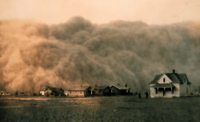
Photo from wikipedia
This study aims to synthesize a dust suppressant for controlling coal dust pollution in open yards using natural polymers. Guided by graft copolymerization theory, potassium persulfate acts as an initiator… Click to show full abstract
This study aims to synthesize a dust suppressant for controlling coal dust pollution in open yards using natural polymers. Guided by graft copolymerization theory, potassium persulfate acts as an initiator to excite the free radicals of collagen and sodium alginate, allowing them to combine with acrylic acid and acrylamide to form a new polymer. The TG curve indicates that the thermal stability of the polymer is superior to that of the raw material. Scanning electron microscope (SEM) images show that the product can reduce the generation of dust by bonding the pulverized coal. With CCD method, when the monomer concentration increases in a certain range, the cohesive ability of the product to coal increases first and then decreases. Initiators and crosslinkers showed the same pattern. A series of performance experiments show that the product has a dust suppression rate of 98.7% at a wind speed of 14 m/s, and maintain one of 94.5% at a wind speed of 8 m/s after a rainstorm. In addition, there was no significant loss in dust suppression performance and compressive strength of the solidified layer after wind and rain. Sunlight, low temperature, and high temperature have little influence on the dust suppression effect of the product, which indicates that the product has better weather resistance and helps to suppress dust for a longer time in open air conditions.
Journal Title: Environmental Science and Pollution Research
Year Published: 2020
Link to full text (if available)
Share on Social Media: Sign Up to like & get
recommendations!